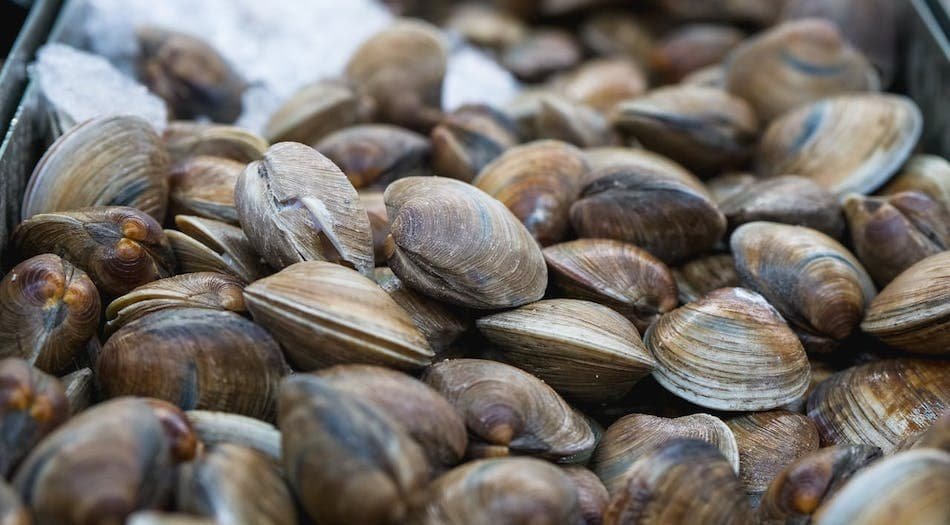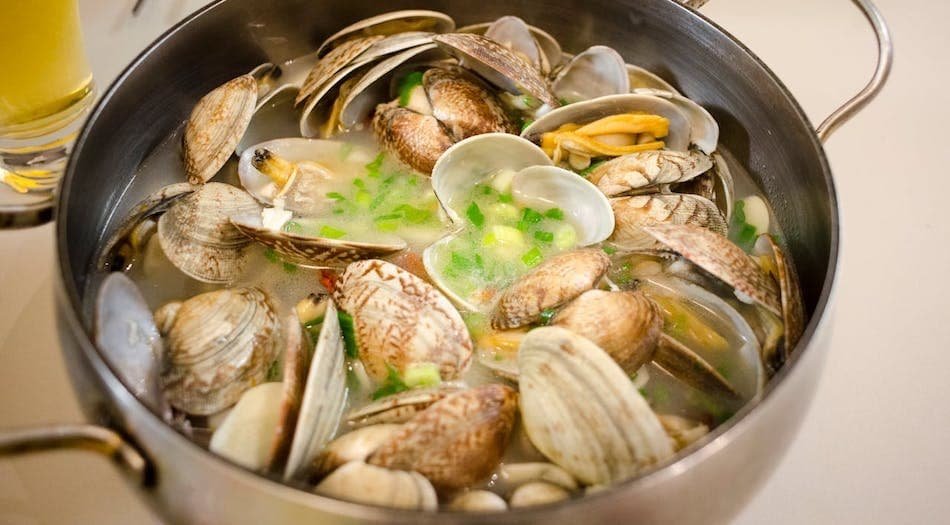If you’re a seafood lover and a dog owner, chances are you’ve wondered whether your canine companion can safely share in the delight of your favorite bivalves. When your four-legged friend’s eyes light up while you slurp down your seafood platter at dinner, do you find yourself thinking, “can dogs eat clams?” The quick answer is yes, dogs can eat clams. But there’s a right and a wrong way to serve clams to dogs, so read on for how to prepare clams properly for our furry friends.

Before introducing any new foods to your dog’s diet, always consult your vet. Individual dogs may have different intolerances, dietary needs, and health considerations. This article is not a substitute for professional veterinary advice.
What Are Clams Exactly?
Clams fall under the mollusc family within the category of bivalves. They inhabit water bodies and are a common delicacy in human cuisine across many cultures worldwide. Despite their small size, they pack an impressive nutritional punch providing a good source of high-quality protein, essential fatty acids, and important vitamins and minerals.

Health Benefits of Clams for Dogs
Due to their rich nutrients clams offer numerous health benefits to your pooch when prepared suitably. Clams can be a nutritious addition to a dog’s diet, offering a variety of essentials that support overall health. Incorporating clams into a balanced diet can provide unique benefits for canine well-being.
High Quality Protein
Clams are an excellent source of lean protein necessary for your dog’s muscle development and maintenance.
Minerals
This seafood provides essential minerals, such as iron, zinc, magnesium, phosphorus, and calcium, which support several crucial bodily processes.
- Iron is vital for blood formation and helps prevent anaemia
- Zinc plays a key role in maintaining a healthy immune system and promoting wound healing.
- Magnesium contributes to muscle and nerve function
- Phosphorus is important for energy production and the formation of bones and teeth.
- Calcium is essential for bone health and proper functioning of the nervous system.
These minerals help with various physiological functions in dogs to be maintained optimally, contributing to their overall health and vitality.
Vitamins
Rich in vitamin B12 which can contribute significantly to your dog’s brain function and overall well-being. Also vitamin C helps to boost the immune system.
Risks of Dogs Eating Clams
Feeding clams to your dog comes with potential risks that call for caution. Attention should be given to proper preparation, avoiding excess preservatives, and the possibility of inherent dangers related to molluscs.
Heavy Metal Contamination
Like most seafood, clams can accumulate heavy metals like lead and cadmium in their bodies. Over time, these metals can pose a risk to your dog’s health if consumed in large quantities.
Bacterial & Parasitic Diseases
There’s the risk of your dog contracting diseases from consuming raw contaminated shellfish. The bacteria present can cause digestive distress like diarrhea and vomiting.
Allergies
Seafood allergies are not common among dogs however they can occur. Symptoms can vary from itching, lethargy, and in severe cases, difficulty in breathing. Always check with your veterinarian before introducing new foods to your dog, and monitor your dog closely the first time they eat clams.

Preparing Clams For Dogs
You might now be wondering what the best way for preparing clams for dogs’ diet. For starters, your pooch can eat both fresh and frozen clams if cooked appropriately. Raw clams should be off the menu for your dog.
- Always source clams from reputable sources to minimize the possibilities of toxic contaminants
- Clean the shell thoroughly before cooking.
- Steam the clams in plain water until they open.
- Remove the clam meat and let it cool.
- Carefully inspect the cooked clam meat for shell fragments before feeding.
- Add clams to dog food or as a treat, but keep it a small amount.
Always consult with your vet when introducing new food into your dog’s diet.
FAQs
Some commonly asked questions about feeding dog clams.
Can Dogs Chew On Clam Shells?
As much as clam shells might look appealing for a chew treat, they pose significant risk factors to dogs. They can easily break into sharp fragments causing injuries in your dog’s mouth, throat or oesophagus. It is recommended to always discard clam shells responsibly after you have removed the meat.
Can Dogs Eat Clam Chowder?
Due to added ingredients like onions and garlic, which are toxic to dogs, clam chowder is generally unsuitable for dogs. Sodium levels in the soup can also pose health risks. It is best to only feed your dog the clam meat plain, separated from potential hazards.
Can Dogs Have Canned Clams?
Can dogs eat canned clams? Canned clams can be an acceptable treat for your dog, but make sure to opt for versions with no added salt or other harmful preservatives or seasonings. Also, rinse thoroughly to reduce any potential sodium content.
Is Clam Juice ok for Dogs?
Provided it is free of additives and extra seasoning, clam juice can be safe for dogs in small quantities. Again, moderation is key.
Are Dogs Allergic to Clams?
It is possible for dogs to be allergic to seafood, including clams. Some may show sensitivities whilst others may be allergic. Look out for symptoms such as itching, vomiting or lethargy upon their initial consumption.
Final Verdict on Can Dogs Eat Clams
In moderation and appropriate preparation, adding clams to your canine companion’s diet can offer health benefits from their richness in proteins and important nutrients. However, an excess may lead to problems related to mineral toxicity. To keep things safe and enjoyable for your dog, serve clams plain without added salt or flavorings, as an occasional treat rather than a regular feature of their diet.





